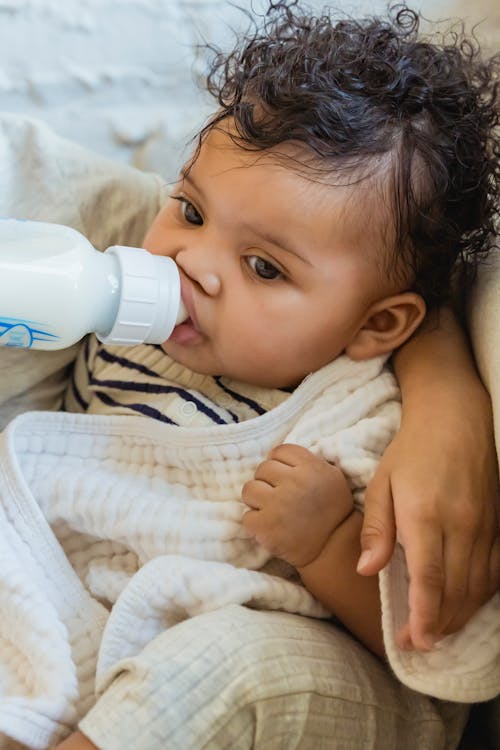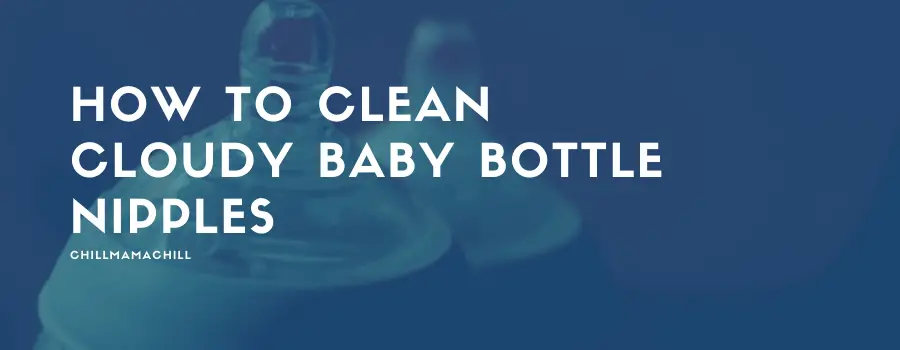Whether it’s for formula feed or your breast milk, every bottle-feeding mum soon finds themselves faced with unsightly, whitish-colored rubber teats. That’s not what you want, and neither does your suckling tot. The residue could clog up the tiny end holes or become a breeding ground for harmful microbes. It’s essential, therefore, for healthier and happier feed sessions to learn how to clean cloudy baby bottle nipples.
Soak baby bottle nipples in 10 parts water and one of white vinegar for at least half an hour to dilute the cloudy discoloration. Let the stubborn whitish stains sit overnight. With a bit of baking powder, sterilize teats and make them less prone to bacteria buildup.
Continue reading for tips on getting rid of baby bottle nipple cloudiness, as well as how you can keep the sterilized yet clear. If you take my advice, you’ll no longer have to throw out nipples if they still possess structural integrity.
Why Do Baby Bottle Nipples Become Cloudy?
Baby bottle nipples come in many designs, and the traditional bell-shaped teat is most commonly used today. Another primary ergonomics focus is on flow control, anti-vacuum venting, and natural or orthodontic shapes. Some emulate the real breast’s nipple’s form, while others innovatively prevent collapse while controlling how fast or slow the liquid’s flow.
It’s your breast milk or formula’s proteins and fat, plus fruit juice residue. Heat sterilization also creates cloudiness on your child’s feeding bottle’s nipple. You could be pumping or exclusively bottle feeding. But it’s how you clean the nipples plus their materials or makeup determines how fast they become cloudy.
The clouding of teats will be induced by;
Materials of Baby Bottle Nipples
Due to their material makeup, feeding teats are impacted by hot temperatures, especially when you microwave or machine dish-wash to sanitize. Baby bottle nipples are made from silicone or latex, and you can identify these materials by the teat coloration and heat resistance.

Silicone-made teats are clear, dishwasher safe, and won’t cloud up quickly, even in hot water. You can tell a rubber or latex nipple by its golden-brown color as well as how soft it is. Heat will make these clouds faster, especially after sterilization.
The Cleaning Fluids Used to Wash Baby Bottle Nipples
Some cleaning fluids have a chemical called Sodium Lauryl Ether Sulfate, or SLES. The additive can introduce stress to latex or silicone nipples, turning them cloudy. Proteins and fats in breast milk, formula, or fruit juices will naturally attach to rubber due to similarities in structure and chemistry.
When combined with heat, protein and fatty residue bonding become more pronounced, resulting in stickier clouding.
High Temperatures
You want to ensure that your baby’s feeding apparatus is strictly germ, and as such, you can completely avoid heat. Like me, you’ll probably mix hot formula and let it cool to feeding temperatures in the bottle, leading to cloudy nipples.
It’s best to avoid high temperatures when cleaning or sanitizing baby bottle nipples. Keeping cloud-free nipples makes it easier to deal with microbe elimination. Prepare formula feed separately or pour warm breast milk from a non-plastic container to avoid clouding the bottle’s teat.
How Do You Clean Cloudy Baby Bottle Nipples?
As with every feeding appliance for your baby, maintenance is essential if you want cloud-free feeding bottle nipples. Replace teats after three months of use, especially if you notice any indication of deterioration. You may see thinned latex or silicone nips with challenges rebounding to the original shape, swelling, stickiness or tears, and cracks.

Liquids can also be pouring out as a stream instead of drops, indicative of widened or torn holes. Tears and breaks can become choking hazards, so don’t use that nipple to feed your child. Wash your baby bottles in lukewarm water instead of hot water to reduce teat brittleness and clouding.
Steps to Cleaning Cloudy Baby Bottle Nipples
- Wash your hands and take apart the bottle by unscrewing the cap to push the nipple from the holding ring. You can use this cleaning method for all the other parts of this baby feeding appliance.
- Rinse the cloudy nipple under running cold water to rinse off milk or juice residues. Wash your baby bottle and other feeding apparatus in a designated container.
- In a basin, take dish soap that doesn’t contain SLES and is gentle on latex or silicone nipples and wash them in warm water. You can use a soft brush to scrub within the teats, cleaning around the holes to unclog them. If there’s dried-up material inside the teat, soak the nipple until the water can freely drip through.
- You can also machine dish-wash your baby bottle nipple after doing the rinse or soak processes I’ve mentioned. Use a closed laundry mesh bag to clean many nipples and place them away from hot bottom drawer elements on the top shelf.
After cleaning, soak the nipples in a solution of one part water and ten parts white vinegar. When yours contain stubborn cloudiness, use more vinegar in the solution and let the teats sit for 30 minutes. Rinse well to avoid curdling milk or formula and air dry on a clean towel.
How Can You Sanitize Baby Bottle Nipples without Making Them Turn Cloudy?
You indeed pay close attention to the hygiene of your baby’s bottle, including regularly sterilizing to prevent stomach upsets. While you may have preferred to microwave or place it in boiling water, your bottle’s nipple can be sanitized without having it turn cloudy from the high heat. One item that’s swung the battle against coliforms to the mum’s favor is the electric sterilizer.
However, ensure that there is no limescale in the electric sanitizer. That can contribute to turning your baby bottle’s nipples cloudy. By soaking the nipple in a solution of 1 tablespoon of baking powder to a gallon of warm water, you can also effectively sterilize your child’s feeding teats without risking cloudiness. Let the nipple sit with the solution overnight and wash it thoroughly the next morning.
Conclusion
To lift cloudy stains off your baby bottle nipples, I recommend natural, handy items like baking soda and white vinegar. Not only will the microbe-friendly ecosystem within rubber or silicone teats be obliterated, but you can use these ingredients to fend off hazy milk, juice, or residual cereal smells from bottles.
The electric sterilizer trumps others when it comes to keeping bottle nipples germ-free. Don’t worry if you haven’t access to one, as you can use the sanitizing option of your dishwasher or a microwave oven every couple of weeks.

I’m Cathrine and I’m a 39-year-old mother of 3 from Utica, New York. And I’m extremely happy you’ve come to visit my hide-out on the web. Here I post about everything related to family-life and usually it will involve babies and lessons I’ve learned over the years from experts, friends, and my own mistakes. So hopefully you will find what i write fun and informational!


